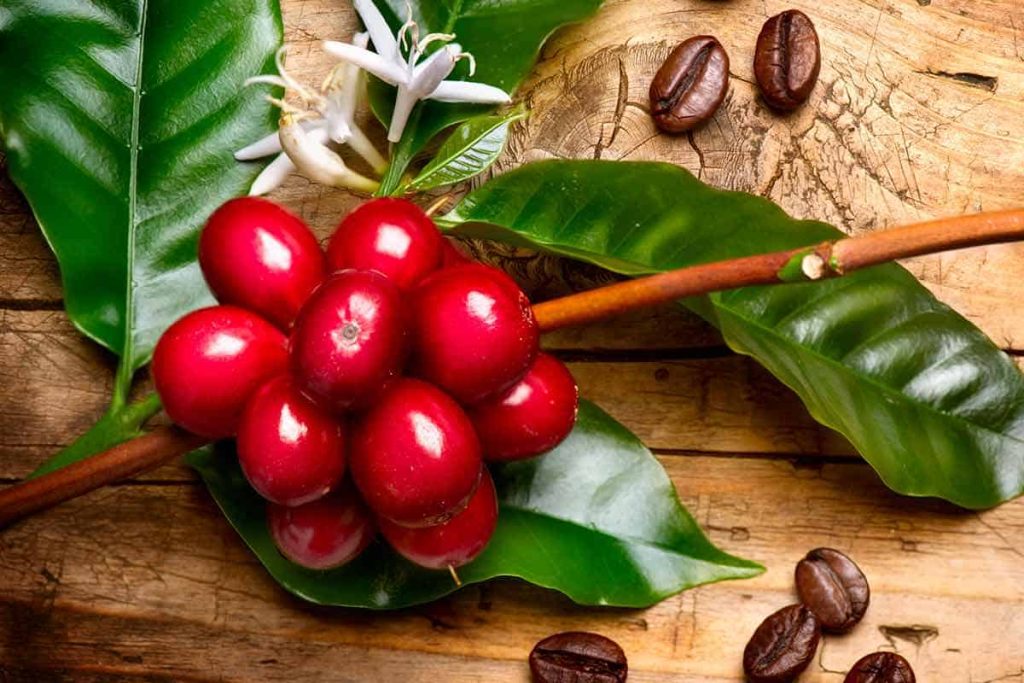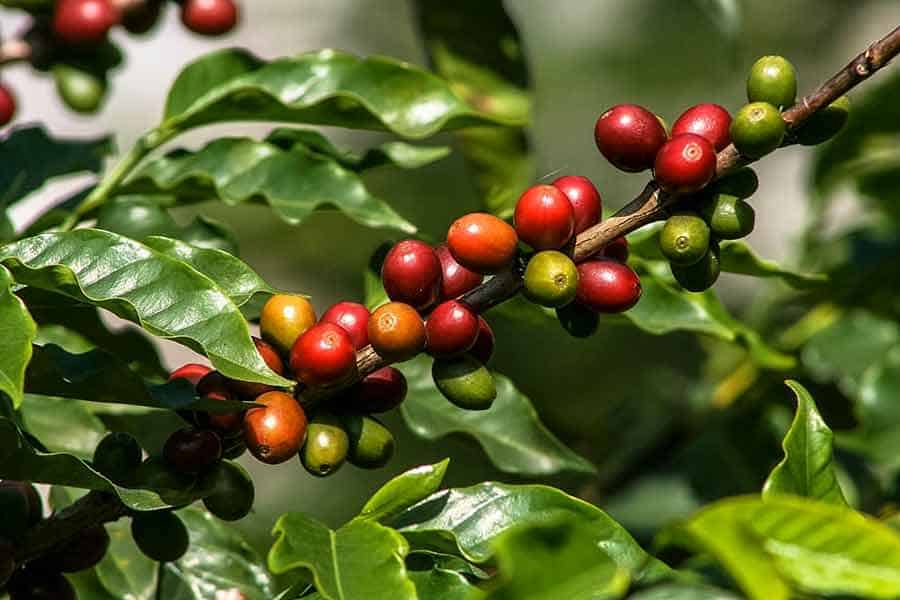How Do Coffee Beans Grow and Other Burning Questions

If you are fairly new to the coffee scene, you may not know that coffee beans are actually the seeds of berry-like fruit. Or maybe you already knew that much but would like to find out exactly how coffee beans grow.
First, you should know that coffee plants take three to six years to grow and mature before they are harvested and roasted for your morning brew. This time frame will be much longer when growing hundreds of trees to harvest the beans for commercial use.
If you are curious about how those delicious golden-brown beans are created, fire up your trusty espresso machine, curl up with a mug of your favorite blend, and stick with me while I explain how coffee beans grow.
The Basics on the Coffee Plant
Before learning how coffee beans are grown, it is important to understand a bit more about the plant. The coffee plant, which originated in Ethiopia, is a bush-like tree that bears rich, red, berry-like fruits. These fruits hold the coffee plant seed, which you are now drinking in your hot cup of joe.
The seeds of the plant are what we enjoy in our morning cuppas. This seed needs to go through multiple processes to be extracted from the fruit, dried, and roasted before you can enjoy the chocolate or fruity flavors, which vary widely depending on the type of bean you have.

Arabica vs. Robusta
There are many varieties of the coffee plant, but the two most commonly known varieties are Arabica and Robusta. While these two are the most common now, other varieties may become more dominant in the future as farmers invent new plant hybrids and plant new varieties to adapt to changing climates.
Premium coffee comes from the Arabica plant and makes up around 70% of the coffee around the world. These beans are often used in specialty coffees and are ultimately seen as higher-quality beans than other types. You may notice that these beans are more expensive; however, they contain less caffeine than the Robusta variety.
The Robusta plant is a lot easier to grow and can withstand hardier elements. This is why these beans are more commonly found in cheaper coffees. You will often notice that these beans are added to coffee blends to bulk up the bag. The beans are known to have flat flavors, even though they contain more caffeine.
The manner in which these two varieties grow is also a factor in how the beans taste. The Arabica beans grow best in mountainous regions with a cooler climate and higher elevation, making them more difficult to grow and harvest.
The Robusta variety is more robust and can handle warmer climates. These plants are usually found closer to sea level.
Characteristics of a Coffee Plant
The bush-like coffee tree can grow up to 20 feet tall in the wild, but farmers prefer to prune them to around five-seven feet tall for easier maintenance and harvesting. These trees are also known to live up to 80 years in extreme cases, yet most live between 30 to 40 years.
The coffee plant has long stems with pairs of waxy green leaves. The leaves are important to convert the sunlight into food for the plant. Small white flowers will begin to appear near the leaves, which eventually fall off to make way for the coffee fruit to blossom.
These berry-like fruits grow in bunches near the leaves of the plant. The fruit starts off yellowy-green but turns a deep red color (or a variation of this depending on the type of plant) when it is near harvesting time.
How Do Coffee Beans Grow? Tips for Planting One at Home
Growing coffee requires both patience and attention, but the results are definitely worth it. If you decide to try your hand at growing your own coffee plant at home, you can then roast the beans and prepare yourself a truly fresh cup of coffee.
You can plant the raw, unroasted coffee seeds to grow more coffee trees. While we may call them beans, they are, in essence, seeds of the coffee plants. So how do coffee beans grow?
These seeds should be planted in shady areas — coffee plants do not flourish in harsh sunlight. They can be planted indoors or outdoors, as long as there isn’t a lot of direct sunlight on them. This is especially crucial for the seedlings that will not survive the sun and require frequent watering to survive.
Once the seedlings have grown sturdier, you can move them to a sunny spot, where they will form strong roots. It is essential to plant them with plenty of space around them to allow the plant to grow fully. You should be planting the coffee seeds during the wet season to ensure the soil stays moist while the roots are developing.
An Arabica plant will thrive in temperatures ranging between 53 to 80ºF and does best in slightly acidic and permeable soil. This is due to the roots needing to establish themselves.
The Arabica plant favors higher altitudes, primarily on hilly areas, whereas the Robusta species can be planted much closer to sea level.
Coffee plants require plenty of water since they are usually found in humid climates. This means you should regularly water the plant and ensure the soil is moist but not waterlogged. Misting the leaves from time to time will also help the plant grow as they are naturally misted in their original habitat.

FAQs
Can I grow a coffee plant at home?
Coffee plants can be grown at home with a lot of care and patience. The plants require specific conditions to grow well and produce quality beans. If you live at a high altitude with a cool climate, you will be able to grow Arabica beans, whereas if you are close to sea level, you will need to plant Robusta beans.
Making sure the plant is watered enough is essential, and be sure to keep the plant out of direct sunlight — the prime condition for coffee trees is in the shade.
How is coffee grown?
Coffee was first discovered growing naturally in Ethiopia from a bush-like tree that bore ruby-red fruits and waxy green leaves. The plant thrives in moist conditions and certain high elevations, depending on the plant. In commercial coffee farming, the trees are grown in rows and harvested by hand.
While the Robusta species is hardy and can grow easily in warmer climates, the Arabica plant needs more attention and care to produce premium coffee beans.
Where do coffee plants come from?
The first coffee plants were discovered in Ethiopia, which is situated on the African continent. It is believed that a goat herder noticed his herd becoming energetic after consuming fruit from a specific plant — the coffee plant. After trying the beans himself, he realized the energizing qualities of the fruit.
Now, coffee plants are grown around the world in Colombia, Brazil, Asia, and of course Africa, as well as other countries. The dominant area that coffee plants are found in is the coffee belt, which is an area that falls between the Tropics of Capricorn and Cancer. These areas offer prime conditions for the plants to grow.
Do certain plants produce decaf coffee beans?
No, there are no coffee beans that are naturally free of caffeine. It is an intrinsic element of the plant species. Decaf coffee beans are created through decaffeination processes that occur before roasting the beans. While there are various processes you can use, the water-based soaking methods of removing caffeine are the most natural.
These methods extract the caffeine without removing the coffee flavors or adding unwanted chemicals to the beans. No decaffeinated process can remove all of the caffeine from the beans, but some methods can remove up to 99.9% of the caffeine.
Props to the Coffee Farmer!
If you are situated in a good climate for growing coffee plants, then you shouldn’t have too much trouble growing your own plant at home. The process will take time and a lot of patience, but when you sip on your first truly homemade cup of fresh coffee, it will all be worth it.
Remember, once the beans have been harvested and dried out, you can roast them at home using various methods before you grind the beans and brew them using your favorite home brewing method.
Owen is a writer and editor at Caffe Streets who considers himself a coffee fanatic. He spends his time researching and testing different coffee beans and brewing methods and sharing what he learns with others.





